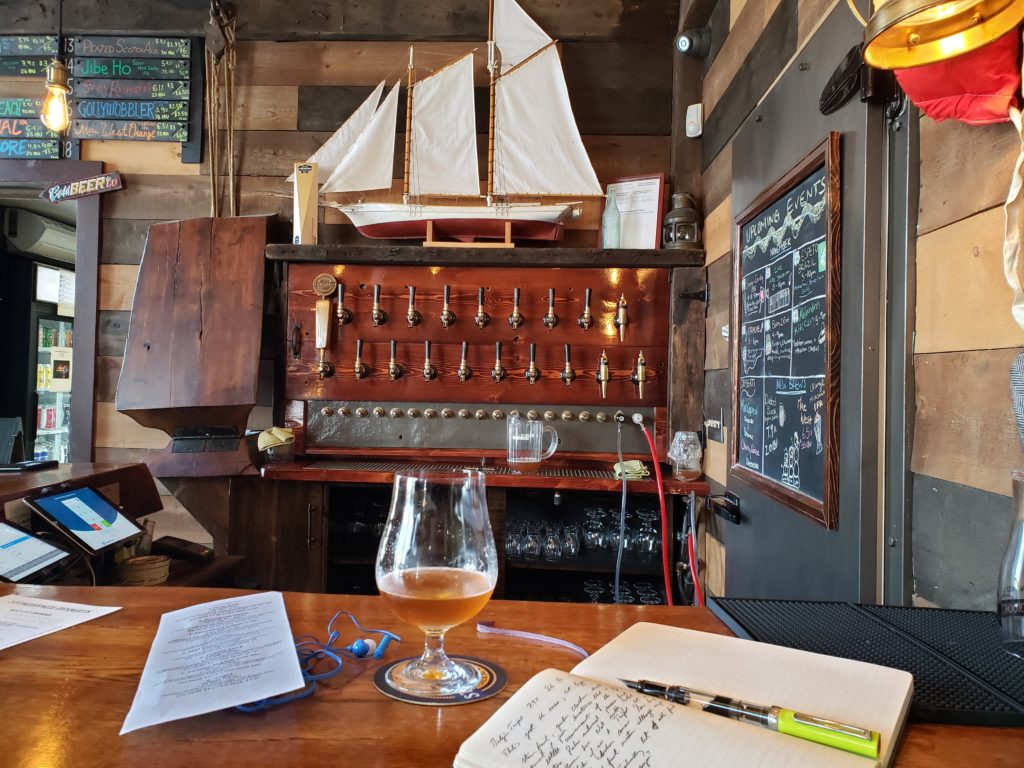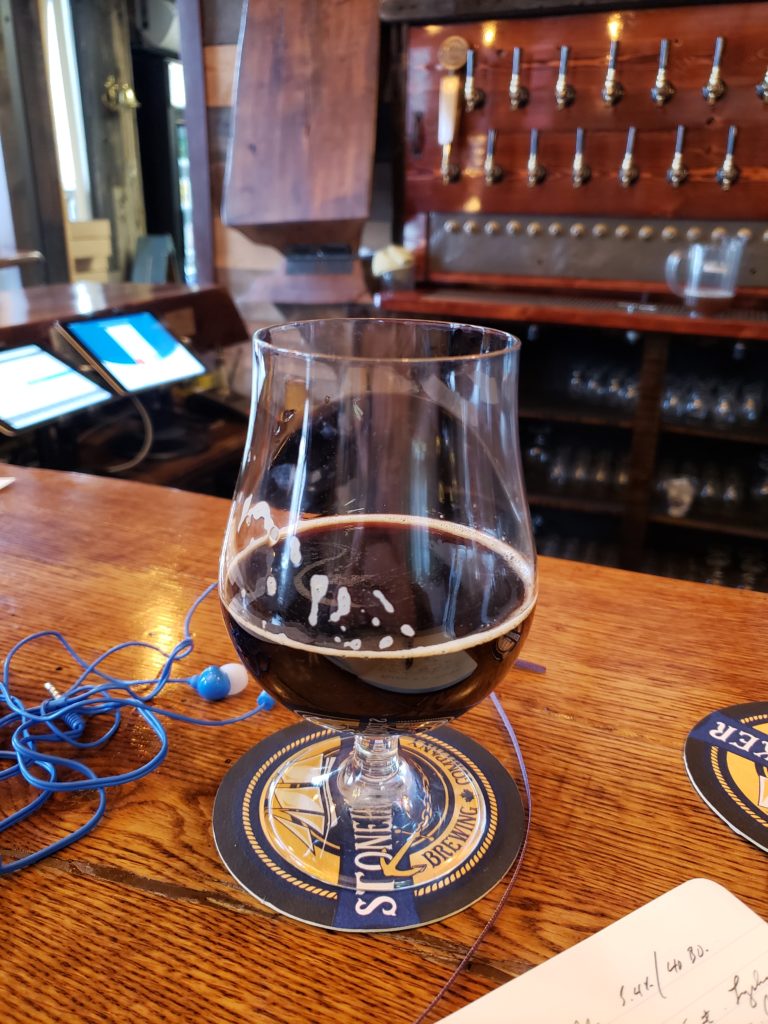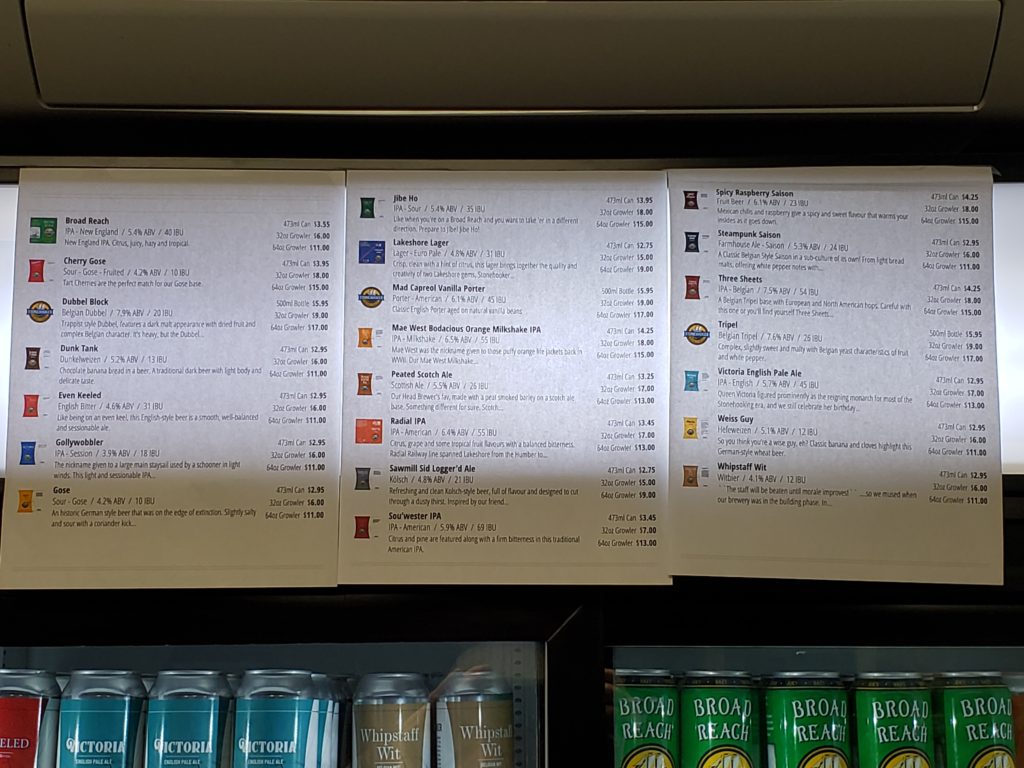The Go Train is familiar, but I’m usually pushing on to the end of the line, either Burlington to transfer to Niagara College or Aldershot for Hamilton. The stations between Exhibition and that distant west end of the line dot the landscape between unfamiliar supermarkets and big box stores; the backsides of neighbourhood restaurants petering out in their third decade of strip mall life, likely as not to be replaced by Go adjacent condos once the ownership has had enough and the land value has appreciated.
It’s the sprawl of in-between places, but Long Branch is just past the TTC, close to being its westernmost point. The 501 loop is comfortably across the parking lot and some year when I have the time I might laze back through New Toronto and Mimico towards Yonge; an hour and a half out on a good day past a hundred freshly salted blocks of people’s lives and aspirations.
I had run into Ross Noel at the MBAA Iron Brewer event earlier in the autumn and said I’d be out there to visit that week. With the podcast, things frequently have a way of cropping up that get in the way. It took me six weeks to find the time to get to Stonehooker, halfway between Long Branch and Port Credit. It is just far enough out that you have to google the transit.
Many of the earliest settlements on Lake Ontario would have been along river mouths, and Stonehooker is halfway between Etobicoke Creek and the Credit River. It’s named after a profession unique to this geography. The Laurentide glacier, receding, dropped stone across Lake Iroquois as it melted and as Lake Iroquois drained down the St. Lawrence the lake bed heaved up in isostatic rebound unearthing stone of its own. The limestone is all further inland, and if you wanted stone west of Toronto, your quarry was the lakebed.
A stonehooker was someone that dredged stone from the shallows of the lake. The job requires a long handled fork with two bent tines to catch the edges of a slab under that water that is cold even in July and presently unthinkable. Judging depth through that treacherous lens, the job is to heave the rock through the resistance of the water and sell it on to construction. You can feel the strain between your shoulder blades and thews just considering the logistics of a six foot pull. And with each extracted stone, the finite amount of building material on the coastline decreases and the job becomes more difficult and the handle of the fork gets longer. At one time there were 23 modified schooners in Port Credit. No longer.
Sitting in the snug of the nautically themed taproom next to a whimsical “ship happens” placard, I’m struck by the attention to detail. The vault of the roof is that of a capsized vessel, with individual ribs, pillars decked out as spars, and captains chairs at the lower tables. The room is all wood and stone with model ships, nautical lanterns, and authentic jetsam.
Stonehooker strikes a distinct note of interstitiality. It’s between Port Credit and Long Branch, between Etobicoke Creek and the Credit River, glaciation and drought. Conceptually, the lake fever has crept in everywhere to the names of the beers and the lived experience of the place. I’d looked at the website and the beers are split somewhat haphazardly between the New World and the Traditional.
Three samples in and from my left someone says “what’re you writing, poetry?” and I say “sorta.” I’d place him about fifty-five, but the room bustles briefly in activity with twenty somethings as well, it being three o’clock on a friday. They all come at it from different places but they all end up with the Gose. The younger drinkers are curious because they know the Collective Arts version, but my new friend is pronouncing it goose. That’s ok. He’s never had one before.
He drinks a lot of Guinness, he says, because he doesn’t like the carbonation. A little later he laments the recent absence of Caffreys from the market. For a guy who knows what he likes, he’s ordered seven 4oz samples right off the top from the list of sixteen with the caveat to the young barman that they shouldn’t be too carbonated. At one point, he says something like “well, sure but this isn’t craft beer, is it?” He’s already making notes on which ones he likes best, and sure enough it’s the Gose, and he’s planning to bring his friends back later.
Just past the end of the 501 line, gateway beer still hauls them in. That said, there’s an audience to convert that has not had a lot of attention paid to them. As a result, Stonehooker is trying to be all things to everyone. The tap list has 18 slots, with two currently empty. I’m hard pressed to think of any other brewery in the GTA with that many of their own beers on tap. Even Amsterdam has fewer than that. Ross Noel says when groups of people come in, having seen the picnic tables out front, it’s amazing how people’s tastes will vary. You don’t want to turn anyone away.
If you’re lucky, a brewery won’t have off flavours to contend with, and that’s certainly true of Stonehooker’s beers. Everything is clean, which speaks to the quality of the brewer. The Sawmill Sid Logger’d Ale (named for the industrious fellow who supplied reclaimed timber from the Gooderham and Worts distillery for the taproom) is maybe the most on style of the beers on tap. The esters are pear and peach with a small amount of confectioner’s sugar and not too far off the Gaffel Kolsch I had on tap the previous week. Maybe a little less refined, but that’s no insult compared to the genuine article. It’s yeast led, which is the point.
The Gose, which won an Ontario Brewing Award this year, puts me in mind of nothing so much as tiny boxes of cereal in the back of the car on a childhood road trip: Corn Pops, I think, all puffed grain and saline minerality. I think the beer needs more coriander to balance it out, but it’s clearly popular with visitors so why make them doubt the previous visit?
Periodically, I get the sense that 18 beers would be a lot to maintain. Some of these beers are re-using constituent elements and are not unlike each other. Take the Steampunk Saison, my notes verbatim: “Quite Sweet, Graham Cracker malt character, a little golden raisin or apricot jam character here. Low carbonation for a Saison. Mild notes of spicy orange peel amidst that.” It struck me as closer to Fuller’s ESB with the yeast switched out than a classic Saison. The Belgian style Tripel struck me as a larger version of the same beer. Still stone fruit and graham cracker, but with the intensity dialled up, reaching towards peach nectar. Checking in with the brewmaster, Adam Cherry, he confirmed that the ingredient builds were similar.
If the malt driven beers tend to lean toward the darker end of the range of flavours per style, the hoppy beers nearly float. Take Gollywobbler (named for a small sail used in light winds), a Session IPA. Built on Galaxy and Mosaic hops, the interest here is light apricot and a small green floral presence with an extremely light bitterness at 18 BU. Broadreach IPA, their newly LCBO bound flagship pulls more character out of a similar hop bill (simcoe and centennial added) for dragon fruit, lychee, papaya and the ghost of a pineapple with a touch of eucalyptus or finger mint on the gulp. I wouldn’t call them assertive, even in the new world of haze and dry hopping.
There’s a lot to like about Stonehooker. For one thing, their thematic consistency is impressive. The nautical element threads through everything they do. They’re clearly listening to their customer base. As I’m visiting, they’re preparing to create a separate seating area in the back by moving their canning line to another part of the facility. People still want to watch the hockey, but no one wants to ruin the ambiance of the front room. They’re providing people reasons to visit. They have food trucks and live music scheduled on the chalkboard in the taproom.
For my preference, I think they’re trying to do too much in terms of variety. If your brewery is six months old and you have eighteen beers on tap, call six to eight of them rotating, it’s going to be very difficult to work in any particular direction. You’re going to end up with beers for the sake of beers. I’m not saying that they’re going to be bad, but the necessity of their existence is such that the time and effort that could go to refining existing recipes will probably go to innovation. But maybe that’s the name working for them; pulling in whatever they can in irregular shapes and sizes to be used somewhere down the line in constructing themselves.
On the Go Train back to the city, I’m looking out the window fondly at the 501 until we pull out of sight of it. Sometimes you’re pulled in a lot of directions and there isn’t much time.




Pingback: These Are Ye Beere News For Yon Thursdayish This Month From Yuletide – Read Beer